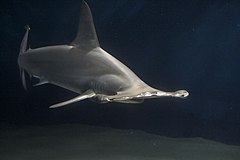
Sharks have keen olfactory senses, located in the short duct (which is not fused, unlike bony fish) between the anterior and posterior nasal openings, with some species able to detect as little as one part per million of blood in seawater. They are more attracted to the chemicals found in the guts of many species, and as a result often linger near or in sewage outfalls. Some species, such as nurse sharks, have external barbels that greatly increase their ability to sense prey.
Sharks generally rely on their superior sense of smell to find prey, but at closer range they also use the lateral lines running along their sides to sense movement in the water, and also employ special sensory pores on their heads (Ampullae of Lorenzini) to detect electrical fields created by prey and the ambient electric fields of the ocean.
0 comments:
Post a Comment